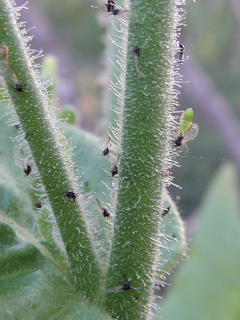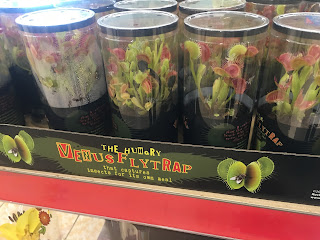Over the next couple of episodes we are going to be dipping into a different group of life than we usually do, the plants. Mike has been getting back into carnivorous plant rearing and wants to share all he knows about the world of plants that eat bugs. How the tables can turn!
Darwin's drawings of the leaves and tentacles of a sundew (Drosera rotundifolia), Figures 1, 4, and 5 from "Insectivorous Plants" (1897), in the public domain.
Aphids and other small insects caught in the sticky trichomes of Nicotiana insecticida, a newly described species of tobacco from Australia. Photograph by Maarten Christenhusz, Figure 1 in Chase & Lambkin (2021).
Phylogeny angiosperm plants with carnivorous taxa indicated by numbered circles. Illustration by Andreas Fleischmann, in Fleischmann et al. (2017) "Evolution of carnivory in angiosperms" in Ellison & Adamec (eds) "Carnivorous Plants: Physiology, ecology, and evolution".
A wetland in Loyalsock State Forest, Lycoming County, Pennsylvania that is home to temperate sundews. Photography by Nicholas_T via Flickr, used under a CC BY 2.0 license.
Tropical swamp in New Caledonia, habitat for Drosera neocaledonica. Photograph by Boaz Ng via Flickr, used under a CC BY-NC-ND 2.0 license.
Utricularia jamesoniana growing as an epiphyte on a tree. Photography by Dr. Alexey Yakovlev via Flickr, used under a CC BY-SA 2.0 license
Utricularia corunta growing as a dense matt in an aquatic habitat. Photograph by peupleloup via Flickr, used under a CC BY-SA 2.0 license.
Catopsis berteroniana in the Florida Everglades growing as an epiphyte in the upper branches of mangrove trees. Photograph by Scott Zona via Flickr, used under a CC BY-NC 2.0 license.
Albany pitcher plant (Cephalotus follicularis) in culture. Photograph by Lucas Arrrrgh via Flickr, used under a CC BY-NC-ND 2.0 license.
Wild Nepenthes mirabilis growing in Hong Kong. Photograph by Boaz Ng via Flickr, used under a CC BY-NC-ND 2.0 license.
Nepenthes albomarginata growing from on a cliff side above a beach. This species has white trichomes around the rim of the pitcher that are attractive to foraging termites. Photograph by Bernard DUPONT via Flickr, used under a CC BY-SA 2.0 license.
Nepenthes ampularia are a species that have adapted away from carnivory and instead capture leaves that fall from the canopy. Photograph by CIFOR via Flickr, used under a CC BY-NC-ND 2.0 license.
A spoon-leaved sundew, Drosera spatulata. This species has a circumboreal distribution with an isolated population also found in the highlands of Borneo. Photograph by Boaz Ng via Flickr, used under a CC BY-NC-ND 2.0 license.
Forked-leaf sundews (Drosera binata) in the wild. Photograph by Doug Beckers via Flickr, used under a CC BY-SA 2.0 license.
Oblong-leaved sundews (Drosera intermedia), showing the semi-aquatic habitat of this species. Photograph by Ashley Basil via Flickr, used under a CC BY 2.0 license.
Vining sundew showing the round sticky traps along the vine and flowers. Photograph by Jean and Fred Hort via Flickr, used under a CC BY 2.0 license.
Wild Venus fly trap in a natural environment. Photograph by NC Wetlands via Flickr, in the public domain.
Venus fly traps being sold commercially. Photograph by Mike Mozart via Flickr, used under a CC BY 2.0 license.
A waterwheel plant (Aldrovanda vesiculosa), which have snap traps and are closely related to Venus fly traps. This species is at risk in their native range but have been introduced into North America, where they may be invasive. This specimen was photographed at Fort AP Hill in New York, USA. Photograph by the U.S. Government, in the public domain.
Individual Aldrovanda nodes showing the whorl of leaves and snap traps. Photograph by David Short via Flickr, used under a CC BY 2.0 license.
A young dewy pine (Drosophyllum lusitanicum) grown in culture. While this sticky-leaved plant may look like a sundew, they are only distantly related to one another. Photograph by incidencematrix via Flickr, used under a CC BY 2.0 license.
Abundant prey captured by a dewy pine. Photograph by incidencematrix via Flickr, used under a CC BY 2.0 license.
Young Triphyophylum plants showing the characteristic wavy primary leaves. Photograph by Carel Jongkind via iNaturalist, used under a CC BY-NC 4.0 license.
Secondary carnivorous leaves of Triphyophylum. Photograph by Lotus-Salvinia.de via Flickr.
Tertiary leaves of Triphyophylum, note the the apical hooks. Photograph by Carel Jongkind via iNaturalist, used under a CC BY-NC 4.0 license.
Questions? Comments?
Follow the show on Twitter @Arthro_Podshow
Follow the hosts on Twitter @bugmanjon, @JodyBugsmeUNL, and @MSkvarla36
Get the show through Apple Podcast, Stitcher, Spotify, or your favorite podcatching app!
If you can spare a moment, we appreciate when you subscribe to the show on those apps or when you take time to leave a review!

























